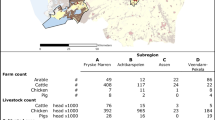Abstract
Increased demand for meat products has led to increased livestock production in Vietnam, which now risks environmental pollution from inappropriate animal manure management on livestock farms. Biogas technology is generally considered an efficient solution for such farms to produce renewable biofuel for use in the household and to reduce the pollution impact from animal waste. However, with biogas technology, farmers may reduce their use of manure for fertilising crops. This field survey investigated nutrient flows on small- and medium-scale livestock farms with and without biogas in Northern Vietnam, in order to identify existing problems and possibilities for sustainable livestock production. A field survey was conducted on 12 pig farms with biogas and 12 pig farms without biogas in Quoc Oai district, Hanoi city. In general, the non-biogas pig farms used on average 3.8 ton compost and 3.1 ton fresh solid manure ha−1 crop−1 for each of three crops typically grown per year on their arable land. They discharged on average 16 % of the total manure produced into the environment in liquid form through the public sewage system. On biogas pig farms, the use of fresh solid manure for crops and discharge of liquid manure was lower, as manure was used to produce biogas. However, excessive use of washing water on several of these farms resulted in very dilute slurry (solid manure:water ratio 1:11) entering the biogas digester. This lowered the retention time in the digester (below the optimum range of 35–55 days), leading to low biogas production rates and possible accumulation of sediment. The digestate was also highly diluted and hence difficult and costly to transport and apply to crops, so it was largely (60 %) discharged to the environment. The input volume of washing water should therefore be reduced to a ratio of 1:5. For better sustainability, appropriate technologies are needed to absorb nutrients from the digestate before discharge and to recycle these nutrients to crops.




Similar content being viewed by others
References
Association of Official Analytical Chemists (1990) Official methods of analysis, 15th edn. Association of Official Analytical Chemists, Inc., Arlington
Chinh NQ (2005) Dairy cattle development: environment consequence and pollution control option in Hanoi province, North Vietnam. Research report No. 2005-RR2006. Published by the Economy and Environment Program for Southeast Asia (EEPSEA), Singapore
Gerber P, Chilonda P, Franceschini G, Menzi H (2004) Geographical determinants and environmental implications of livestock production intensification in Asia. Biores Tech 96:263–276
Hedlund A, Witter E, Bui XA (2003) Assessment of N, P and K management by nutrient balances and flows on peri-urban smallholder farms in southern Vietnam. Eur J Agron 20:71–87
IAEA (2008) Guidelines for sustainable manure management in Asian livestock production systems. ISBN 978–92–0–111607–9. Printed by the IAEA in Austria, May 2008
Kristoferson LA, Bokalders V (1991) Renewable energy technologies—their application in developing countries. ITDG Publishing, London
Møller HB, Sommer SG et al (2004) Methane productivity of manure, straw and solid fractions of manure. Biomass Bioenergy 26:485–495
Nguyen MK, Pham QH, O¨born I (2007) Nutrient flows in small-scale peri-urban vegetable farming systems in Southeast Asia—a case study in Hanoi. Agric Ecosyst Environ 122:192–202
Nielsen LH, Hjort-Gregersen K (2002) Socio-economic analysis of centralised biogas plants. Working paper, Danish Research Institute of Food Economics. http://orgprints.org/10820/1/10820.pdf. Accessed 17 Apr 2012
Phong LT, Stoorvogel JJ, van Mensvoort MEF, Udo HMJ (2011) Modeling the soil nutrient balance of integrated agriculture aquaculture systems in the Mekong Delta, Vietnam. Nutr Cycl Agroecosyst 90:33–49
Sasse L (1988) Biogas plants a publication of the Deutsches Zentrum für Entwicklungstechnologien—GATE. In: Deutsche Gesellschaft für Technische Zusammenarbeit (GTZ) GmbH—1988
Singh PP, Ghuman BS, Grewal NS (1998) Computer model for performance prediction and optimization of unheated biogas plant. Energy Convers Manag 39:51–63
SNV-VN (2012) Biogas program for animal husbandry sector in Vietnam. Program supported by Netherlands Development Organisation. http://www.biogas.org.vn/. Accessed 17 Apr 2012
Sommer GS, Mathanpaal G, Dass GT (2003a) A simple biofilter for treatment of pig slurry in Malaysia. Environ Tech 26:303–312
Sommer SG, Mathanpaal G, Dass GT (2003b) A simple biofilter for treatment of pig slurry in Malaysia. Environ Technol 26:303–312
Sommer SG, Petersen SO, Møller HB (2004) Algorithm for calculating methane and nitrous oxide emission from manure management. Nutr Cycl Agroecosyst 69:143–154
Tamminga S, Jongbloed AW, Van EMM, Aarts HFM, Mandersloot F, Hoogervorst NJP, Westhoek H (2000) The forfaitaire excretie van stikstof door landbouwhuisdieren [Standards for the excretion of nitrogen by farm animals], Rapport ID-Lelystad no. 00-2040R, (2000) 71 pp, Instituut voor Dierhouderij en Diergezondheid, Lelystad, The Netherlands
Thu CTT, Cuong PH, Hang LT, Chao NV, Anh LX, Trach NX, Sommer SG (2012) Manure management practices on biogas and non-biogas pig farms in developing countries using livestock farms in Vietnam as an example. J Clean Prod 27:64–71
Tran MT, Vu TKV, Sommer GS, Jensen LS (2011) Nitrogen turnover and loss during storage of slurry and composting of solid manure under typical Vietnamese farming conditions. J Agric Sci 149:285–296
Vu TKV, Tran MT, Dang TTS (2007) A survey of manure management on pig farms in Northern Vietnam. J Livest Sci 112:288–297
Vu TKV, Sommer GS, Vu CC, Jørgensen H (2010) Assessing nitrogen and phosphorus in excreta from grower-finisher pigs fed prevalent rations in Vietnam. Asian-Australas J Anim Sci 23:279–286
Acknowledgments
This survey was carried out by participants of the SUSANE II—research project, which is financially supported by the Danish Foreign Ministry and the Vietnamese Ministry of Agriculture and Rural Development.
Author information
Authors and Affiliations
Corresponding author
Rights and permissions
About this article
Cite this article
Vu, Q.D., Tran, T.M., Nguyen, P.D. et al. Effect of biogas technology on nutrient flows for small- and medium-scale pig farms in Vietnam. Nutr Cycl Agroecosyst 94, 1–13 (2012). https://doi.org/10.1007/s10705-012-9516-y
Received:
Accepted:
Published:
Issue Date:
DOI: https://doi.org/10.1007/s10705-012-9516-y




